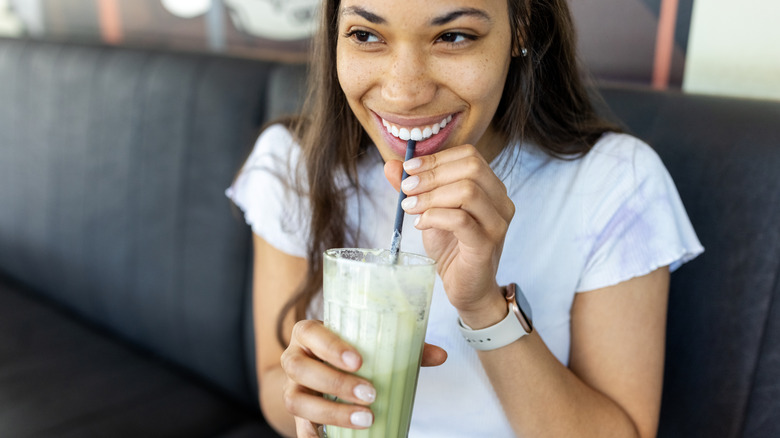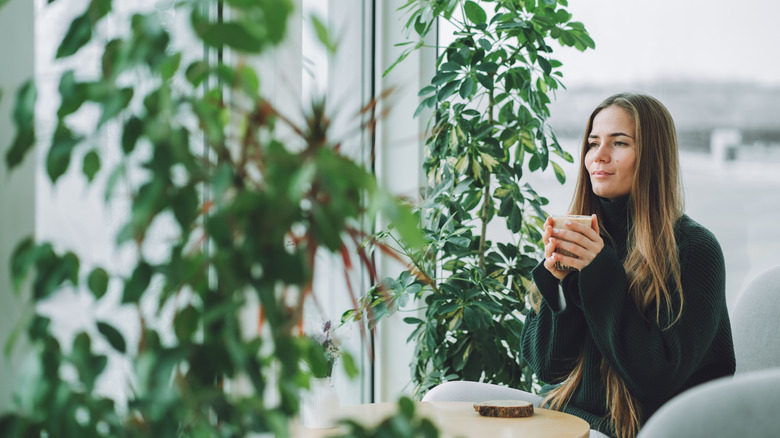How Much Caffeine Is Usually In Matcha?
In today's coffee shops, we have more options for our morning brew than ever before. Espresso drinks are everywhere, coffee's served hot and cold, and there are many more teas to choose from than just green and black. Coffee shops introduce international favorites to menus regularly, and while the olive oil-based Oleato was a flop for Starbucks, matcha has soared in popularity. Of course, matcha has been a popular drink in Asia for hundreds of years, particularly in Japan, but you may be wondering if it packs the same punch as your regular morning latte. Starbucks says its grande matcha latte has 65 mg of caffeine per 16 ounces. By comparison, the café's grande espresso latte contains 150 mg. But it's not so cut and dry.
The caffeine content in an average cup of coffee can vary wildly — the U.S. Food & Drug Administration says a "regular brewed, non-specialty" 12-ounce cup of coffee can have anywhere from 113 to 247 mg of caffeine. That's a pretty wide range, and the method of preparation and coffee beans you use can complicate that further. Matcha, however, really isn't much like coffee. It's technically a kind of green tea, albeit stone-ground and used as a powder. Regular green tea has considerably less caffeine than coffee, at 30 to 50 mg per eight-ounce cup, and that can also be affected by the method of preparation. Brewed matcha delivers around 70 mg of caffeine for a fraction of the ounces, so it's considerably more potent, but that 16-ounce Starbucks matcha latte isn't all matcha powder. Like an espresso drink, the amount of ground tea leaves used in a cup of matcha is small, and the rest is water, milk, and sugar.
Why Does Matcha Pack So Much Caffeine in a Little Package?
So, if matcha is just ground-up green tea leaves, how does it have so much more caffeine than a typical cup of brewed green tea? The difference chiefly lies in what part of the tea leaves you're drinking.
Regular green tea is made by using hot water to soak leaves from the Camellia sinensis plant, usually packaged in a tea bag or sold loose-leaf. When you pour out the steeped tea from a teapot or remove the bag from your cup, the actual leaves are filtered out. Matcha powder, on the other hand, is made of whole leaves. The powder is mixed with hot water until it froths, and the amount of water you use can change the consistency of the drink. From there, you can add milk and sweeteners to make a latte or whatever kind of barista drink you like.
Matcha powder tastes pretty bitter, so a teaspoon or two is typically all you need. As that amount equates to about 70 mg of caffeine, you can do the math to figure out how much actual powder is in a Starbucks grande matcha latte. A little goes a long way.
Order a Dirty Matcha for a Bigger Jolt of Caffeine
With matcha and espresso sitting so close to each other on more and more coffee shop menus, it's only natural for adventurous coffee and tea lovers to wonder: what happens if you mix them together? Enter the dirty matcha, a somewhat controversial but super popular latte that mixes matcha and espresso.
Like the dirty chai, another blend of tea and coffee, a dirty matcha is made by combining a shot of brewed matcha, a shot of espresso, milk, and your sweetener or syrup of choice. It can also be made iced with a few cubes dropped in. Devotees swear by the drink largely because of the unique interplay between that grassy matcha flavor and the bold acidic taste of espresso.
But with two particularly caffeine-rich beverages meeting in one glass, you might wonder if the jolt of energy a dirty matcha gives you will be considerably more intense than a standard latte. A shot of matcha has about the same amount of caffeine as a shot of espresso, which means that, together, they have about as much caffeine as a standard cup of coffee. The FDA puts the threshold for a healthy amount of caffeine per day at 400 mg, so a dirty matcha isn't going to give you the jitters any worse than your average latte will.


